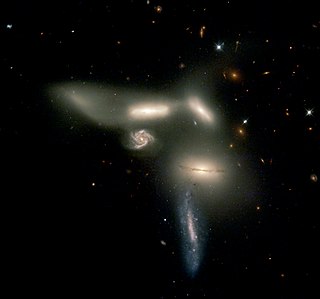
Seyfert's Sextet is a group of galaxies about 190 million light-years away in the constellation Serpens. The group appears to contain six members, but one of the galaxies, NGC 6027d, is a background object and another "galaxy," NGC 6027e, is actually a part of the tail from galaxy NGC 6027. The gravitational interaction among these galaxies should continue for hundreds of millions of years. Ultimately, the galaxies will merge to form a single giant elliptical galaxy.

Stephan's Quintet is a visual grouping of five galaxies of which four form the first compact galaxy group ever discovered. The group, visible in the constellation Pegasus, was discovered by Édouard Stephan in 1877 at the Marseille Observatory. The group is the most studied of all the compact galaxy groups. The brightest member of the visual grouping is NGC 7320, which has extensive H II regions, identified as red blobs, where active star formation is occurring.

The Leo Triplet is a small group of galaxies about 35 million light-years away in the constellation Leo. This galaxy group consists of the spiral galaxies M65, M66, and NGC 3628.
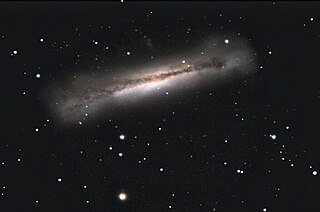
NGC 3628, also known as the Hamburger Galaxy or Sarah's Galaxy, is an unbarred spiral galaxy about 35 million light-years away in the constellation Leo. It was discovered by William Herschel in 1784. It has an approximately 300,000 light-years long tidal tail. Along with M65 and M66, NGC 3628 forms the Leo Triplet, a small group of galaxies. Its most conspicuous feature is the broad and obscuring band of dust located along the outer edge of its spiral arms, effectively transecting the galaxy to the view from Earth.
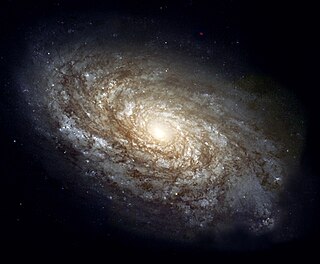
NGC 4414, also known as the Dusty Spiral Galaxy, is an unbarred spiral galaxy about 62 million light-years away in the constellation Coma Berenices. It was discovered by German-British astronomer William Herschel on 13 March 1785.
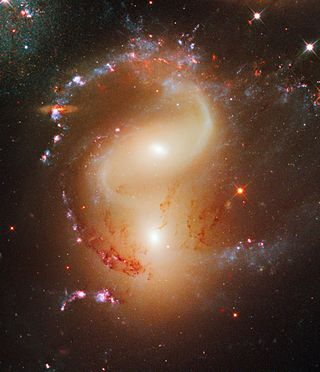
NGC 7318 is a pair of colliding galaxies about 280 million light-years from Earth. They appear in the Constellation Pegasus and are members of Stephan's Quintet. They were discovered on 27 September 1873 by French astronomer Édouard Stephan.
A Hickson Compact Group is a collection of galaxies designated as published by Paul Hickson in 1982.

NGC 88 is a barred spiral galaxy exhibiting an inner ring structure located about 160 million light years from the Earth in the Phoenix constellation. NGC 88 is interacting with the galaxies NGC 92, NGC 87 and NGC 89. It is part of a family of galaxies called Robert's Quartet discovered by astronomer John Herschel in the 1830s.

NGC 7331 Group is a visual grouping of galaxies in the constellation Pegasus. Spiral galaxy NGC 7331 is a foreground galaxy in the same field as the collection, which is also called the Deer Lick Group. It contains four other members, affectionately referred to as the "fleas": the lenticular or unbarred spirals NGC 7335 and NGC 7336, the barred spiral galaxy NGC 7337 and the elliptical galaxy NGC 7340. These galaxies lie at distances of approximately 332, 365, 348 and 294 million light years, respectively. Although adjacent on the sky, this collection is not a galaxy group, as NGC 7331 itself is not gravitationally associated with the far more distant "fleas"; indeed, even they are separated by far more than the normal distances of a galaxy group.

NGC 5754 is a barred spiral galaxy located 218 million light years away in the constellation Boötes. It was discovered by German-British astronomer William Herschel on 16 May 1787.
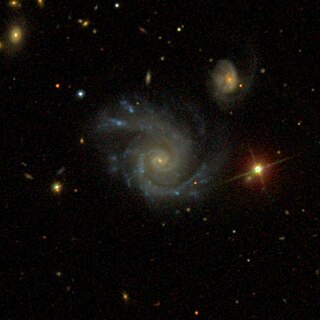
NGC 5829 is a spiral galaxy located in the constellation Boötes. It is 281 million light-years away from Earth and was discovered by astronomer, Edouard Stephan in May 1882.

NGC 6845 is an interacting system of four galaxies in the constellation Telescopium. The cluster has certain similarities with Stephan's Quintet. Its distance is estimated to be about 90 Mpc.

A galaxy group or group of galaxies (GrG) is an aggregation of galaxies comprising about 50 or fewer gravitationally bound members, each at least as luminous as the Milky Way (about 1010 times the luminosity of the Sun); collections of galaxies larger than groups that are first-order clustering are called galaxy clusters. The groups and clusters of galaxies can themselves be clustered, into superclusters of galaxies.
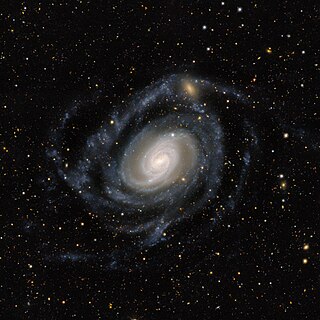
NGC 289 is a spiral galaxy in the southern constellation of Sculptor, located at a distance of 76 megalight-years from the Milky Way. It was discovered on September 27, 1834, by John Herschel. The compiler of the New General Catalogue, John Louis Emil Dreyer, noted that NGC 289 was "pretty bright, large, extended, between 2 considerably bright stars". The plane of the galaxy is inclined by an angle of 45° to the line of sight from the Earth.
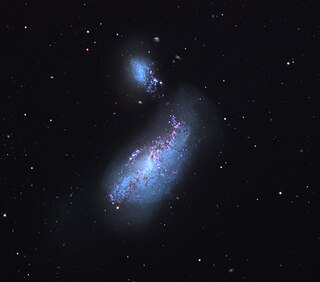
NGC 4490, also known as the Cocoon Galaxy, is a barred spiral galaxy in the constellation Canes Venatici. William Herschel discovered it in 1788. It is known to be of the closest interacting/merging galactic system. The galaxy lies at a distance of 25 million light years from Earth making it located in the local universe. It interacts with its smaller companion NGC 4485 and as a result is a starburst galaxy. NGC 4490 and NGC 4485 are collectively known in the Atlas of Peculiar Galaxies as Arp 269. The two galaxies has already made their closest approach and are rushing away from each other. It's been discovered that NGC 4490 has a double nucleus.
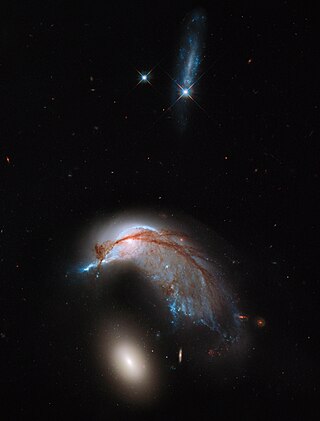
NGC 2936, also known as the Penguin Galaxy or the Porpoise Galaxy, is an interacting spiral galaxy located at a distance of 326 million light years, in the constellation Hydra. NGC 2936 is interacting with elliptical galaxy NGC 2937, located just beneath it. They were both discovered by Albert Marth on Mar 3, 1864. To some astronomers, the galaxy looks like a penguin or a porpoise. NGC 2936, NGC 2937, and PGC 1237172 are included in the Atlas of Peculiar Galaxies as Arp 142 in the category "Galaxy triplet".

The Copeland Septet is a group of galaxies in the constellation Leo that includes NGC 3748, NGC 3754, NGC 3750, NGC 3751, NGC 3745, NGC 3753 and NGC 3746. The group was discovered by British astronomer Ralph Copeland in 1874. The location of Copeland's Septet is right ascension 11h 37m 50s / declination +21° 59′ (2000.0), about three degrees northwest of third magnitude star 93 Leonis.

Wild's Triplet, also known as Arp 248, is a group of three small, interacting spiral galaxies. The galaxies are visible in the constellation Virgo. Two of the galaxies have a connecting stellar stream, probably formed as a result of gravitational tidal interactions. The trio is located some 200 million light-years away. The triplet is named after the Swiss astronomer Paul Wild (1925–2014), who studied the trio in the early 1950s.
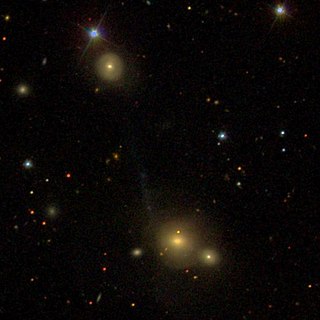
Zwicky's Triplet is a group of three galaxies visible in the constellation Hercules.



















